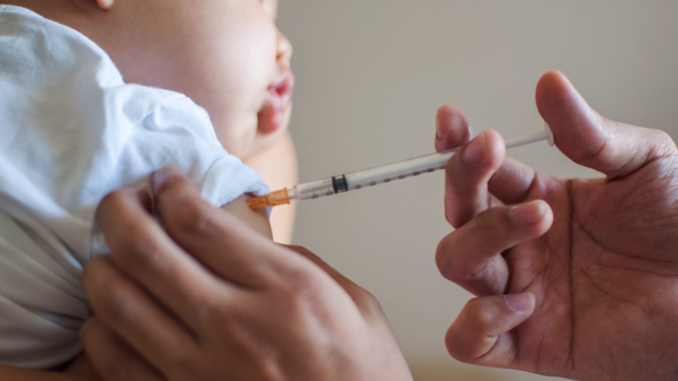
Original Article by Angelo DePalma, Ph.D. John-Michael Dumais
Young children may be getting “double the authorized dose” of Moderna’s COVID-19 vaccine — a mistake that could have serious consequences, medical professionals told The Defender.
According to a Nov. 1 U.S. Food and Drug Administration (FDA) advisory, the agency “has become aware that some healthcare providers may not recognize that the single dose vial of Moderna COVID-19 Vaccine (2023-2024 Formula) for use in individuals 6 months through 11 years of age contains notably more than 0.25 mL [milliliters] of the vaccine.”
The FDA said some healthcare providers “may be withdrawing the entire contents of the vial to administer to an individual.” Adults receive a dose of 0.50 mL.
The FDA did not elaborate on how it came by the information on dosing errors. However, according to the advisory, the agency had “not identified any safety risks associated with administration of the higher dose in individuals 6 months through 11 years of age” and “no serious adverse events were identified related to a dosing error for the vaccine.”
Dr. Elizabeth Mumper, a pediatrician and president and CEO of The Rimland Center for Integrative Medicine, told The Defender she had concerns about the mistaken doses.
Mumper said a child who receives more than the recommended amount “will have more exposure to synthetic modified RNA, lipid nanoparticles and potentially DNA plasmid contamination.”
Even with the appropriate dose, Mumper said, there is no guarantee that the baby or child will make the “just right” amount of spike protein to induce just the right amount of immune response.
“I worry about over-producing the spike protein and getting side effects,” Mumper said.
Dr. Renata Moon, also a pediatrician, told The Defender:
“The only appropriate dose of this mRNA shot for children is no dose. Children shouldn’t be injected with it at all. We have an avalanche of highly concerning data regarding the risks of this product.
“Experienced, frontline physicians are being censored, silenced and threatened for speaking out. Our nation’s children deserve better.”
Vaccine packaging unclear
The Moderna product is packaged in four main formats: a 0.25-milliliter pediatric single-dose vial, a 0.50-milliliter adult dose vial, a 0.50-milliliter prefilled syringe and a 2.5-milliliter vial containing five adult doses (primary or booster).
Vaccinators are instructed to draw no more than one dose from single-use vials and not to combine the leftovers from one vial with those from another to create a larger dose.
Mumper said she called the Moderna helpline, as the package insert and FDA documents do not indicate the amount of vaccine in the vials. She said Moderna told her, “There is overfill to assure sufficient volume, but there is no quantity listed.”
“Hopefully, nurses are conscientious about following the directions to only give 0.25 mL,” Mumper said. “Administration errors vary depending on the setting or experience of the nurse or medical assistant.”
The advisory instructed healthcare providers, parents and caregivers with questions to email the agency’s Center for Biologics Evaluation and Research at ocod@fda.hhs.gov.
‘Not like you ordered too many tablecloths or something’
There can be administration errors when new vaccines are rolled out, Mumper said, especially given the different protocols for Moderna and Pfizer vaccines, and different colored labels.
“Mistakes would be expected to occur less often if each office is only using one product. I am worried about administration errors during the learning curve,” she said.
With the Vaccine Adverse Event Reporting System, or VAERS — which captures less than 2% of harms — previously bogged down in reports of post-vaccine injuries and deaths, and with the Centers for Disease Control and Prevention’s discontinuation of the V-safe COVID-19 vaccine harm surveillance program, it is unclear how news of uneventful dosing errors would have reached regulators.
On Nov. 2, a Morrisville, North Carolina, TV station reported that a 5-year-old girl who received an adult dose of the Moderna vaccine experienced a high fever for 12 hours after receiving the shot. The mother learned of the error through a call from her pediatrician’s office.
She told station WRAL, “I understand human error, but this is not like you ordered too many tablecloths or something … You injected something into my child that you can’t get out now.”
Overdosing is not a new problem for COVID-19 shots. According to a 2021 news report, soon after the FDA authorized the immunizations for young children authorities removed at least two Virginia pharmacies from state and federal COVID-19 vaccination programs after they gave 5- to 11-year-olds the dose recommended for kids 12 and older.
Kids are not just ‘little adults’
The FDA has warned that drugs are often given to children without adequate testing or consideration of the differences in how their bodies process them.
Children may clear drugs faster or slower than adults, resulting in overdoses or clinically irrelevant doses which on the surface may appear reasonable based on simple weight conversions.
Many drugs used in pediatrics are prescribed and administered “off-label,” meaning the products were not approved specifically for children — usually because pediatric studies were never done. This results in “many adverse reactions not observed in adults,” according to one study.
Pediatric drug dosing is loosely based on a child’s weight vs. that of a normal-sized adult, but simple calculations cannot account for physiologic and metabolic differences between kids and grownups. For purposes of drug dosing, children are not just “little adults.”
The FDA issued Emergency Use Authorization for COVID-19 vaccines for children ages 5-11 in October 2021, based on a study of 4,700 subjects lasting “months.” No formal, long-term safety tests were conducted.
The Moderna and Pfizer vaccines for children 6 months to 11 years were authorized on June 17, 2022, after just two months of safety monitoring following the second dose in approximately 2,700 subjects ages 6 months to 11 years. Pfizer’s trial included a total of 2,970 subjects through age 4, but only 1,000 were monitored for safety for two months following the third dose.
Before COVID-19, a vaccine development program typically lasted 10-15 years.
A 2022 study linked the Pfizer and Moderna mRNA COVID-19 vaccines to 1 serious adverse event for every 800 vaccinated, a thousandfold higher than the 1 to 2 serious events per million claimed for other vaccines.
The authors of the study said they asked the FDA to issue warnings based on their analysis but no such advisories were issued.
In 2022, Denmark became the first country to halt its COVID-19 vaccination program. Currently, Denmark only recommends vaccination for people 65 and older and certain at-risk populations.
Sweden also stopped recommending the shots for young people, and in March, the World Health Organization (WHO) finally acknowledged that youth are at very low risk from the disease and may not need a shot.
However, fact-checkers were quick to point out that the WHO did not recommend against shots for children, while they continued pushing the shots and promising the unvaccinated and un-boosted yet another “winter of illness and death.”


